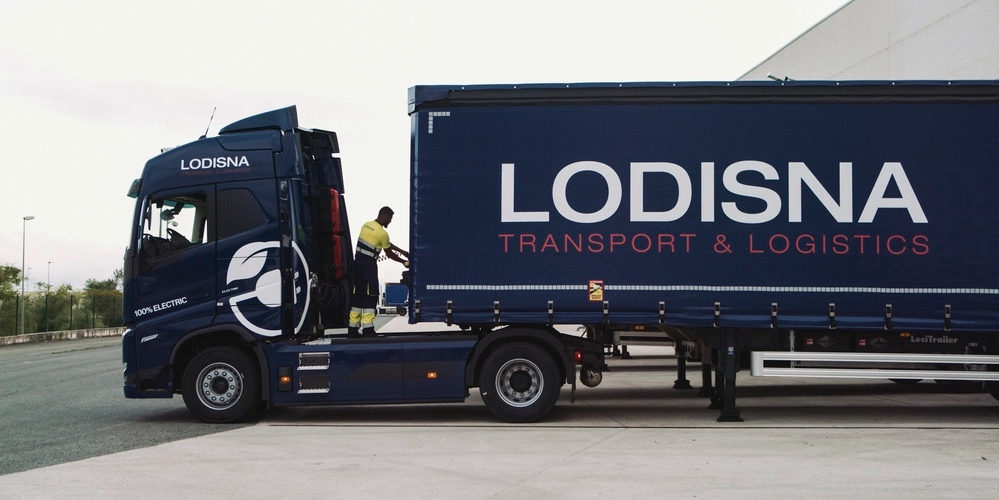
Lodisna’s Strategic Project Manager.
“We have studied numerous operations with different clients to electrify routes, but we face difficulties with chargers because the implementation for eTrucks is not very developed,” says Javier Avello.
Lodisna‘s Strategic Project Manager explains to Mobility Portal España the challenges the national road transport sector must face to meet CO2 emission reduction targets.
According to the Business Association for the Development and Promotion of Electric Mobility (AEDIVE), in the country, more than 1.6 billion tons of goods are transported each year, almost all by road (96 per cent).
This contributes to 23 per cent of total road transport emissions, which represents 94 per cent of total sector emissions.
The electrification of heavy vehicles is crucial and must be complemented by a robust public charging network.
“We are eagerly awaiting AFIR,” comments Avello in this regard.
One of the most notable achievements in Europe in recent years in the transition to electric and sustainable mobility is the publication of the Alternative Fuels Infrastructure Regulation (AFIR).
This sets mandatory national targets that will result in the installation of sufficient infrastructure in the European Union for alternative fuels, intended, among others, for road vehicles.
It is worth noting that this regulation will come into force on April 13th, and there is still much to be done in Spain.
“Charging point providers are doing exceptional work and are making significant progress, but there are many non-operational points due to bureaucratic or licensing issues,” he emphasizes.
AFIR proposes deploying at least 3,600 kW of charging power for heavy transport every 60 km on main roads by 2030 and 1,500 kW every 100 km on secondary roads.
For that same year, an accumulated investment of 7 billion euros in electric trucks is estimated in Spain.
Of this amount, 3.4 billion will be additional investments to transition from combustion to eVehicles.
In total, an accumulated expenditure of 1.4 billion euros is projected for heavy transport charging infrastructure, with 50 per cent allocated to strengthening and extending the network and another 50 per cent for installing new points.
In this regard, Lodisna’s Strategic Project Manager highlights: “I believe all these deadlines will be met by the end of the year, and we will have many more opportunities to carry out these types of routes.”
In order to ensure compliance with AFIR at the national level, AEDIVE proposes the approval of a Heavy Vehicle Charging Infrastructure Plan (PIRVEP).
It also establishes an economic regime that provides certainty to charging point operators about the recovery of their investments and enables the setting of a competitive “refuelling” price.

How does Lodisna contribute to this transition?
While awaiting the implementation of AFIR, Lodisna’s strategy, the company of comprehensive logistics and international Express road transportation, to promote electrification in the sector focuses on building trust.
To achieve this goal, they have designed a project methodology that includes a theoretical analysis phase of the routes the client wishes to undertake.
Subsequently, they conduct a road test with a demo truck, with which they carry out a real test of the routes and recharges, considering all relevant factors.
With all the information gathered during these tests, they prepare a detailed report that they present to the client to generate confidence in the transportation of their goods using electric vehicles.
Not only that, but they also provide advice on subsidy management, among other services.
In this regard, one of the charging solutions they are currently promoting is the implementation of chargers at the user’s facilities.
“This allows them to optimize their time, considering that the truck battery, with a power of between 150 and 180 kW, is replenished in approximately an hour and a half,” explains Avello.
This issue will be resolved in the near future with the implementation of the Megawatt Charging System (MCS).
However, they do not rule out resorting to public charging.
Lodisna is in contact with several charging providers to identify points that fit their routes and logistics operations.
Currently, the company based in Pamplona has both its own drivers and its own fleet composed of 250 trucks, most of which run on diesel or biodiesel.
All of them comply with Euro 6 regulations, meaning they are renewed every three years.
“The average age of our trucks is one and a half years, so we always have the latest technology,” he points out.
Among these vehicles is the Volvo FH Electric, which has a range of up to 300 kilometers, allowing it to cover around 540 km daily with two stops.
“It is one of the eTrucks that covers the most kilometers per week in Spain,” says the Lodisna representative.
Two more electric tractors will be added to this fleet during the course of this year.
“We are looking for applications, use cases, and strategies to introduce eTrucks, even for long-distance routes, such as implementing operations with relays,” concludes Javier Avello.






